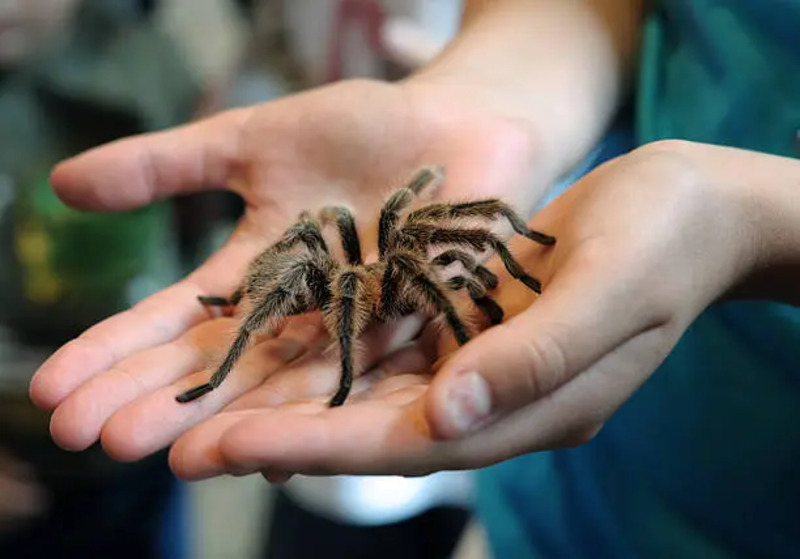
Tarantula as Pets
Published on June 26, 2025
Tarantulas, with their hairy bodies and multiple eyes, might not be everyone's idea of a cuddly companion. However, for those fascinated by the unique and exotic, these arachnids can make surprisingly low-maintenance and captivating pets. They are quiet, don't require much space, and can live for many years. But before you bring one home, it's crucial to understand their specific needs and behaviors to ensure a healthy and happy life for your new eight-legged friend.
This guide will delve into the world of tarantula ownership, covering everything from choosing the right species to setting up their habitat and understanding their unique quirks.
Are Tarantulas the Right Pet for You?
Tarantulas are not interactive pets in the traditional sense. They are primarily observational animals, meaning you'll spend more time watching them than handling them. They are ideal for:
- Busy Individuals: Their minimal care requirements fit well into a hectic schedule.
- Small Spaces: A small enclosure is all they need.
- Allergy Sufferers: They are a great alternative for those with allergies to fur or feathers.
- Those Seeking a Unique Pet: They offer a fascinating glimpse into the world of invertebrates.
Choosing Your First Tarantula
For beginners, it's best to start with docile, hardy, and slow-moving species. Some popular beginner-friendly tarantulas include:
- Chilean Rose Hair (Grammostola rosea): Very docile, hardy, and long-lived.
- Curly Hair (Tliltocatl albopilosus): Known for their calm temperament and fuzzy appearance.
- Mexican Red Knee (Brachypelma hamorii): Docile, beautiful, but can be a bit more expensive.
- Brazilian Black (Grammostola pulchra): Very docile and long-lived, with a striking black coloration.
Avoid arboreal (tree-dwelling) species or those known for being fast or defensive for your first tarantula.
Setting Up the Perfect Habitat
A proper enclosure is vital for a tarantula's well-being. The general rule is that the enclosure's length should be 2-3 times the tarantula's leg span, and the width should be 1.5-2 times the leg span.
- Enclosure Type: A glass or plastic terrarium with a secure, escape-proof lid is essential. Ventilation is important, but too much can dry out the substrate.
- Substrate: 4-6 inches of coco fiber, peat moss, or a mix of both. This allows for burrowing and helps maintain humidity.
- Water Dish: A shallow, heavy water dish that won't tip over. Ensure it's always filled with fresh, dechlorinated water.
- Hide: A half-log, cork bark, or a small ceramic pot provides a secure place for your tarantula to retreat and feel safe.
- Temperature & Humidity: Most beginner species thrive at room temperature (70-80°F or 21-27°C). Humidity needs vary by species, but generally, a slightly damp substrate and a full water dish are sufficient. Avoid heat lamps, which can dry out the enclosure and stress the tarantula.
Feeding Your Tarantula
Tarantulas are insectivores. Their primary diet consists of live feeder insects.
- Staple Diet: Crickets, dubia roaches, or mealworms are common choices. Ensure the feeders are gut-loaded (fed nutritious food) before offering them to your tarantula.
- Feeding Frequency: Juveniles may eat 2-3 times a week, while adults typically eat once every 1-2 weeks.
- Prey Size: The feeder insect should be no larger than the tarantula's abdomen.
- Remove Uneaten Prey: Always remove any uneaten live prey after 24 hours to prevent it from stressing or harming your tarantula.
Handling and Temperament
While some tarantulas tolerate handling, it's generally not recommended. They are fragile and can be easily injured if dropped. More importantly, handling can be stressful for the tarantula. If you must handle, do so gently and over a soft surface. Remember, tarantulas can flick urticating (irritating) hairs from their abdomen as a defense mechanism, which can cause itching and irritation to human skin and eyes.
Molting: A Critical Process
Tarantulas grow by molting, shedding their exoskeleton. During this time, they will become lethargic, stop eating, and may lie on their back. It's crucial not to disturb them during a molt, as they are extremely vulnerable. Ensure humidity is adequate to aid in a successful molt. Once they have molted, allow their new exoskeleton to harden for several days before offering food or handling.
Conclusion
Tarantulas offer a unique and rewarding pet ownership experience for those who appreciate their quiet, solitary nature. With proper research, a well-maintained habitat, and a respectful approach to their unique needs, your tarantula can be a fascinating and long-lived companion.